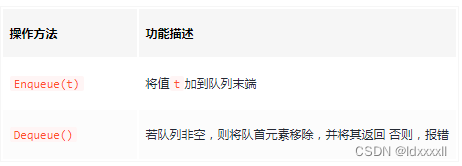介绍
与栈一样,队列也是最基本的数据结构之一。队列也是值的一种容器,其中值的插入和删除遵循“先进先出”(First-In-First-Out, FIFO)的原则⎯⎯也就是说,每次删除的只能是最先插入的值。
实现
队列的抽象数据类型就是一个数组,其中的值排成一个序列,我们只能访问和取出排在最前端(Front)的对象,只能在队列的尾部(Rear)插入新值。正是按照这一规则,才能保证最先被插入的对象首先被删除(FIFO)。
队列首先支持下面的两个基本方法:

此外,与栈类似,队列还支持如下的方法:

基于数组的简单实现
我们使用一个数组来模拟队列,队列的数据结构定义如下:
type T int
type Queue struct {
sync.RWMutex
array []T
}
我们依次去实现队列的方法,对于进队Enqueue()方法,直接利用go原生语句将值添加到数组切片中。
// Enqueue adds t to the end of the queue
func (q *Queue) Enqueue(t T) {
q.Lock()
q.array = append(q.array, t)
q.Unlock()
}
出队Dequeue()和取队首元素Front()时注意数组空判断。
// Dequeue removes the start of from the queue
func (q *Queue) Dequeue() (error, *T) {
q.Lock()
if len(q.array) == 0 {
q.Unlock()
return fmt.Errorf("queue is empty"), nil
}
ret := q.array[0]
q.array = q.array[1:len(q.array)]
q.Unlock()
return nil, &ret
}
// Front returns the start in the queue, without removing it
func (q *Queue) Front() (error, *T) {
q.Lock()
if len(q.array) == 0 {
q.Unlock()
return fmt.Errorf("queue is empty"), nil
}
ret := q.array[0]
q.Unlock()
return nil, &ret
}
剩下Size()以及IsEmpty()即对队列的数组大小进行判断取值。
// Size returns the size of the queue
func (q *Queue) Size() int {
q.RLock()
defer q.RUnlock()
return len(q.array)
}
// IsEmpty returns true if the queue is empty
func (q *Queue) IsEmpty() bool {
q.RLock()
defer q.RUnlock()
return len(q.array) == 0
}
单元测试
这里测试进队和出队方法:
import "testing"
var (
t1 T = 1
t2 T = 2
t3 T = 3
)
func TestQueue_Enqueue(t *testing.T) {
queue := NewQueue()
queue.Enqueue(t1)
queue.Enqueue(t2)
queue.Enqueue(t3)
if size := queue.Size(); size != 3 {
t.Errorf("wrong count, expected 3 and got %d", size)
}
}
func TestQueue_Dequeue(t *testing.T) {
queue := NewQueue()
queue.Enqueue(t1)
queue.Enqueue(t2)
queue.Enqueue(t3)
_, ret := queue.Dequeue()
if *ret != t1 {
t.Errorf("wrong result, expected %d and got %d", *ret, t1)
}
_, _ = queue.Dequeue()
_, ret = queue.Dequeue()
if *ret != t3 {
t.Errorf("wrong result, expected %d and got %d", *ret, t3)
}
err, _ := queue.Dequeue()
if !queue.IsEmpty() {
t.Errorf("IsEmpty should return true")
}
if err == nil {
t.Errorf("cannot operate dequeue when queue is empty")
}
}
至此,单元测试通过,我们就完成了队列数据结构的实现。





















 899
899











 被折叠的 条评论
为什么被折叠?
被折叠的 条评论
为什么被折叠?










